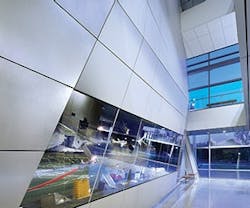NASA Langley Research Center Headquarters
The first of six new facilities planned for NASA’s Langley Research Center in Hampton, Va., the Langley Headquarters Building could be called an unexpected triumph of sustainable design.
Initially requiring only LEED Silver certification, the project’s stakeholders raised the certification target to LEED Gold during the bridging design phase. As the construction phase began, members of the design/build team, led by Cooper Carry, carefully tracked the project’s points and met regularly to review the LEED scorecard.
Thanks to that collaborative spirit and some smart decisions, the project eventually earned LEED Platinum certification. That makes it the first LEED Platinum project completed in the GSA’s Mid-Atlantic Region, and only the second LEED Platinum project for both the GSA and NASA nationally.
“Our interiors team worked closely with the base building team to maximize the substantiality features of this project,” says Karen Trimbach, IIDA, IDEC, associate and project manager with Cooper Carry. “The entire Cooper Carry team including our engineers, H.F. Lenz Company, collaborated closely with NASA and Whiting-Turner, our design-builder, in this effort. We were able to maximize our LEED points by bringing everyone’s ideas to the table and then figuring out how to realize those ideas within the scope of the project.”
The 79,000-square-foot, three-story building is filled with sustainable features ranging from the conventional to the truly innovative, including underfloor air distribution, a closed-loop geothermal heat-exchanger, photovoltaic (PV) elements and a vegetated roof.
The lobby of NASA’s Langley Headquarters Building utilizes recycled glass poured terrazzo flooring that is at once sustainable, durable and easily maintained. The raised access flooring system was procured locally and incorporates significant amounts of recycled content; the carpeting, gypsum board, ceiling tiles and other building materials also incorporate recycled, as well as regional material content. Zero added urea-formaldehyde and low-VOC products in the interior; outdoor air delivery monitoring; and indoor air quality management plans contribute to a healthy indoor environment.
The Langley Headquarters Building houses approximately 240 NASA employees and showcases striking rows of high-efficiency windows and low furniture heights, all of which enable natural light to filter throughout the interior spaces. In addition, solar sensors, shading devices, light shelves and automatic glazing treatments tied to the building automation system further optimize the available daylight and contribute to energy efficiency while increasing occupant comfort. All occupants have the ability to adjust the amount of heating or cooling in their work area by use of personal swirl diffusers which control the underfloor air distribution.
“Through teamwork and a shared passion for sustainability, the team delivered a LEED Platinum building on a LEED Gold budget,” says Lauren Perry Ford, AIA, LEED AP BD+C, sustainability practice group leader with Cooper Carry.
“Each decision was one small step, but taken together, they created one giant leap for sustainable design,” she adds with a wink.
